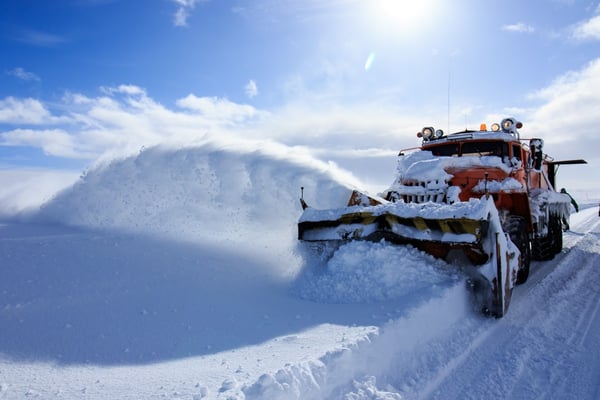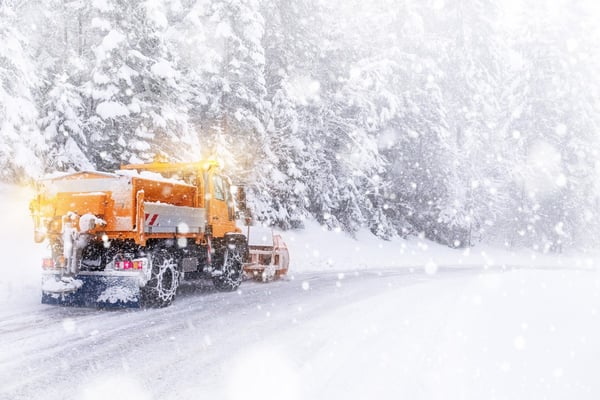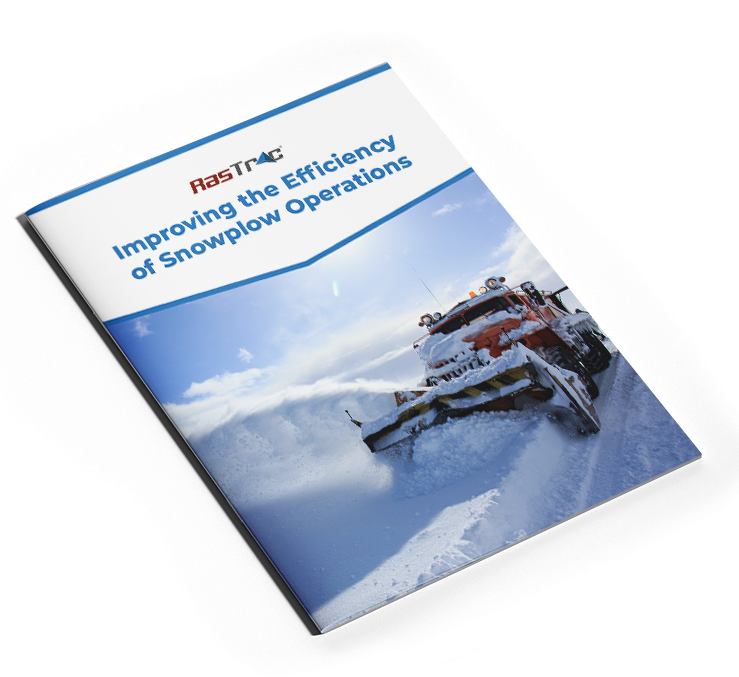The winter season can bring a flurry of fun times and holiday festivities; it can also bring a load of financial and logistical stress to municipalities across the country. As wintry storms increase in frequency and intensity, local governments are battling to keep the roads cleared for their communities while staying under budget.
Snowplow operations play a crucial role in keeping municipalities open, therefore optimizing their efficiency - and other seasonal countermeasures - is important. This article includes practical tips for managing snowplow operations and outlines the benefits of GPS tracking software for your fleet of vehicles.
Quick Links
- The Importance of Efficient Snowplow Operations
- Tips for Productive Snowplowing Operations
- Benefits of Fleet Management Solutions for Snowplow Operations
- Simplifying Snowplow Operations and Fleet Management with Rastrac
-
Benefits of Using GPS Tracking Devices for Snowplow Operations
The Importance of Efficient Snowplow Operations
The winter season creates extremely hazardous road conditions for motorists. According to the U.S. Federal Highway Administration (FHWA), almost 70% of the U.S. population live in snowy regions. Each year, 24% of weather-related accidents occur due to icy, snowy, or slushy road conditions that result in more than 1,300 deaths and 116,800 accident-related injuries.
This is why most municipalities use snowplow operations during the winter to perform regular street cleaning — ensuring all roads remain safe and clear of snow or ice hazards. Some of the biggest challenges municipalities face during the winter season include:
- Managing ice countermeasures;
- Handling equipment maintenance;
- Optimizing snowplowing routes; and
- Minimizing unsafe driving behaviors
Every state, county, and city government has to deal with these challenges on a limited operating budget. Going over-budget for snowplow operations can mean money gets taken away from other projects. This could negatively impact other municipal operations throughout the year. On the other hand, coming in under-budget results in more resources available for other needs and emergencies.
How can municipalities optimize their snowplow operations to overcome these challenges and improve safety for their constituents? What tools can municipalities use to achieve their operational goals?

Tips for Productive Snowplow Operations
Improving the operational efficiency of snowplow vehicles and equipment is a great way to get more done with snowplow vehicles on a tight budget. With this in mind, here are some tips for improving snowplow efficiency:
1: Buy Ice Countermeasures During Warm Months
Rock salt is a perennial favorite countermeasure for preventing the formation of ice on municipal roads. As a common and often inexpensive commodity, rock salt makes for a great, low-cost countermeasure to ice and snow buildup.
However, to minimize costs, it’s important to stock up on rock salt well before you actually need it. This is because shortages of road salt—which often hit when municipalities across the nation all try to stock up for the winter season at once—can dramatically increase the cost of road salt.
As noted in an NPR.org article from after the 2014 winter storm season, “This winter’s relentless snowstorms have depleted stockpiles and pushed the salt industry to its limit… Earlier in the year, a ton of rock salt would cost $50. Now, it can cost $250 or more.”
A few years later, another salt shortage struck the country—leading to another dramatic increase in the cost of this vital snow and ice countermeasure. As noted by Turfscape in one of their blog articles, “Some of the biggest suppliers are already claiming salt shortage and prices have escalated 100% over the 2017-2018 season.”
Waiting until winter is already here is a surefire way to end up having to pay premiums for road salt—assuming that it can be acquired in the first place. Securing road salt in the summer months can help reduce costs significantly.
Additionally, municipalities could attempt to source rock salt from a supplier in the lower hemisphere during winter, as these sources would be experiencing their summers at this time, lowering local demand—the cost savings on the raw product may be able to offset the cost of shipping over long distances.
2: Avoid Over-Plowing Roads
Although it is important to keep roads clear of ice and snow in the winter to ensure the safety of commuters, over-servicing roads by having plows cover the same areas repeatedly is a waste of time, fuel, and other limited resources. Worse, it leaves other roads under-serviced—blocking in vital side streets that could help keep traffic flowing.
Finding ways to ensure that plows are only clearing roads that actually need service and optimizing snowplow routes is critical for avoiding waste of fuel and ice countermeasures. Additionally, by avoiding repeat plowing of the same roads, snowplow fleets can cover more ground.
3: Keep Snowplows Well-Maintained
Extensive vehicle repair is incredibly costly. The longer vehicle maintenance is put off, the costlier it will be in most cases—especially if the plow breaks down on the road.
By focusing on preventative maintenance that keeps your plows in top shape, municipalities can actually reduce the total amount they spend on maintenance.
To optimize maintenance to focus on prevention, snowplow fleet managers need detailed data about each vehicle in the fleet, including:
- Total vehicle mileage;
- Engine performance data;
- How far the vehicle has traveled since its last maintenance check; and
- Onboard diagnostics data of key vehicle systems
Having this information makes it much easier to target the specific maintenance issues that are most likely to become a problem in the future.
4: Monitor Driver Behaviors
Keeping an eye on every driver in a municipal maintenance fleet is easier said than done, but it’s an important part of ensuring efficiency and increasing productivity.
Knowing where drivers have been - and when they were there - is key for tracking how effectively they’re using their time behind the wheel. Bad driving behaviors such as excessive idling, going off-route, accelerating too hard, and sharp braking can all impact safety, efficiency, and productivity in one way or another.
However, most municipalities don’t have the resources to put a supervisor in the passenger seat of every vehicle on every trip. Thankfully, they don’t have to!
Using GPS fleet vehicle tracking for snowplows allows municipal vehicle fleet managers to passively collect key data on how each and every vehicle in the fleet is being used. Even better, many GPS units can tie into a vehicle’s on-board diagnostics system, allowing for the remote collection of key engine performance data—including diagnostic codes that serve as an early warning for when maintenance is needed.
5. Maintain Constant Communication
When a massive snowstorm strikes, it’s critical that your municipality is able to combat it in a systematic and strategic manner. This can only happen with reliable and consistent communication across the many moving parts of your snowplow fleet to make and implement a cohesive plan. Everyone, from the driver to the dispatcher to the manager, should understand and fulfill their responsibilities within your team, which is best accomplished when communication methods are open and utilized.

Benefits of Fleet Management Solutions for Snowplow Operations
There are several perks to utilizing management solutions for your snowplow fleet, such as:
- Optimizing operations to be their most efficient, which better serves your budget and your community during the harsh winter months
- Promoting municipal transparency by monitoring exactly which snowplows have cleared what roads, and when, and follow driving patterns to reduce dangerous driving habits
- Maintaining records of fleet vehicle repairs and timely servicings to ensure the snowplows are kept in good condition
Simplifying Snowplow Operations and Tracking with Rastrac
Several of the tips listed above lean heavily on GPS tracking capabilities to be practical. Telematics solutions with vehicle-mounted GPS devices help municipal fleet managers collect the data that they need to enact safety policies, optimize snowplow routes, and optimize maintenance schedules.
When an advanced GPS tracking system is incorporated into a municipal snowplow fleet, there’s not a rare snowstorm that can’t be handled in a safe and systematic manner. Even with heavy snowfall, snowplow routes can be set to keep important roads clear efficiently—helping to minimize the impact of snow storms while increasing road safety and minimizing costs.
Rastrac’s snowplow GPS tracking solutions are all optimized to help municipalities increase the effectiveness of their snowplow operations so they can focus on more important matters. Here are a few of the ways that Rastrac GPS tracking systems can help:
Weather Alerts
There is no reason for a driver to be unaware of hazardous road conditions, threatening storm developments, or road closures. The National Weather Service is just one of the many organizations that provides weather and climate forecasts, and announces warnings to both the public and private sectors. Systems are available specifically for truckers that display maps demonstrating, in real time, existing weather conditions.
A “Current Forecast Conditions Map,” for example, displays information across the nation specifically indicating “Heavy Snow Possible,” “Severe T-Storm Possible,” or “Flash Flood Possible” weather alerts. A “Current Precipitation Map” displays precipitation across the entire U.S. Truckers don’t have to blindly drive into it anymore to discover that road conditions are dangerous or impassable.
GPS Tracking and Route Optimization
Roads may need to be plowed repeatedly during a lengthy storm. Fleet tracking systems for snowplows have route optimization tools that allow managers to remotely track the specific times that a road was cleared, note the amount of time that has elapsed since the plowing, and plan a designated time to re-plow the road according to the snow and ice conditions.
A route optimization program, such as StreetComplete by Rastrac, features a street map overlay with colors identifying a timeline. The user assigns a specific color to mark a street that has just been plowed. Another color replaces that color after a predetermined period, such as 30 minutes or one hour. Another color will be shown when the street has not been plowed for an extended length of time.
Snowplow progress and street clearing can be remotely monitored, at a glance, by fleet managers in their offices or on-the-go via smartphones. This at-a-glance view of snow clearing operations minimizes the risk of snowplows redoing areas that have been recently completed.
Each vehicle is kept on track to the next destination, and the streets are cleared methodically, with each road kept clear throughout the storm’s progress.
Map Overlays
GPS solutions with map overlays ensure fleet managers make the most efficient and effective use of their snowplow operations by detailing roads that help them plan their strategy according to priority levels. Priority levels identify the most important accessibility roads during snow emergencies. These levels typically include:
- Priority Level One: The highest priority routes are those needed for emergency responders traveling to and from hospitals, fire stations, and police stations. Bridges and steep hills that are likely to freeze are also often designated priority one.
- Priority Level Two: Priority level two routes are completed after level one has been completed. Level two routes are roads that have high levels of traffic and are used to access subdivisions, schools, city recreational resources, and nursing homes.
- Priority Level Three: Level three routes include residential subdivisions and all other remaining roadways. These streets are cleared only after completion of one and two.
On-Board Diagnostic Code Collection
Onboard diagnostics are a huge asset for fleet managers. GPS systems combined with onboard diagnostics provide real-time updates about the engine performance, fuel expenditure, and emissions. Managers receive notifications about engine issues and other problems before the vehicle breaks down, which keeps the fleet running smoothly.
Separate Sensors on Plows
Many plows are now equipped with additional sensors that are directly placed on the plows, which detect air and road temperature, friction, and identify slippery driving conditions. This not only helps to inform the public of dangerous road conditions, it helps fleet managers determine which deicing material will be the most effective, such as:
- Salt: this deicing material costs less than many others, but is most effective after the snow has just fallen and the temperature is approximately 15° Fahrenheit.
- Liquid: chemical deicers typically need to be used before the snow has fallen. They cost more, but less is used, so it can actually be more cost-effective depending on dispersion rate, the base chemical used, and how much of it gets washed away by melting snow.

Benefits of Using GPS Tracking Devices for Snowplow Operations
Why should a municipality use GPS tracking to improve snowplow operations? There are many reasons, including:
Improving Snowplow Efficiency
Managing plowing operations takes a careful balance. Plow and salt roads too frequently, and you’ll just waste fuel, time, and materials. However, taking too long between plow operations can let snow and ice pile dangerously high, which can cause accidents and block road access for commuters.
Being able to track exactly which roads have been plowed and when is a powerful tool for maximizing efficiency and making sure that no road goes too long without being cleared of ice and snow. This is something that GPS tracking for snowplows can help with.
For example, the StreetComplete solution makes optimizing snowplow deployments on the fly super easy, which allows municipalities to avoid re-plowing the same streets over and over in order to focus resources where they’re most needed.
Increasing Safety
Mishaps happen. A snowplow’s engine might seize up from prolonged exposure to the cold, the driver might hit an obstacle that was hidden by snow, or a tire might burst. Whatever the reason, it’s all too easy for a plow, and its driver, to get stranded out in the field.
With GPS tracking for snowplows, municipal fleet managers can easily locate a stranded driver’s last location and send help right away. By sending help right to the last known GPS coordinates, help arrives sooner rather than later and reduces risk of illness or injury from the cold.
Preventing Waste
It would be great if every driver made the best use of their time behind the wheel! Unfortunately, efficiency isn’t guaranteed. Between unofficial side trips and wasteful driving habits, there’s a surprising amount of time, fuel, and rock salt that can go to waste during snowplow operations.
GPS fleet tracking can help municipalities reduce waste in snowplow operations by tracking driver activities. With logs of where each vehicle has traveled, engine idle time, acceleration and braking habits, and other key data, fleet managers can quickly spot wasteful drivers and correct the behaviors that lead to wasted time and resources.
Faster Emergency Snow Clearing Response
Winter weather makes emergency response services more complicated and dangerous. In some situations, there might not be a clear road to an emergency call location. With GPS location data for each of your snowplows in the field, you can quickly identify which plows are closest to the path that emergency responders need to be cleared.
This can save precious minutes on the process of having snowplow drivers call out their locations over the radio to confirm who is the closest. In an emergency response situation, this could save lives.
These are just a few of the ways that using GPS fleet tracking for snowplow operations can help your municipality this winter. Interested in learning on how you can get started on making your municipality safer and more efficient for winter now? Contact Rastrac today!
Like what you're reading? Subscribe to our blog.
Get our latest posts straight to your inbox.
Subscribe to Our Blog

Improve the Efficiency of Snowplow Operations
Overcome the biggest challenges facing snowplow efficiency today.
Download Guide




